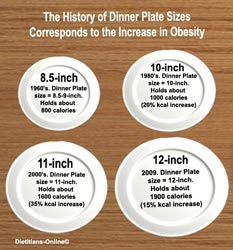This news item expired on Friday, November 30, 2012 so the information below could be outdated or incorrect.
 A new study, published in the August 2012 issue of the Journal of Consumer Research, helps explain why the size of our plates affects how much we’re eating.
A new study, published in the August 2012 issue of the Journal of Consumer Research, helps explain why the size of our plates affects how much we’re eating.
Turns out, our behavior is directly influenced by what our eyes perceive, even when we know better. So, for example, you’ll serve yourself less and eat less on a 6-inch plate than a 9-inch plate because it looks more satisfying.
The study, by Brian Wansink, Cornell researcher and EatingWell advisor suggests the color of your plates, table and tablecloth matters too: using light plates on dark tablecloths helps you eat less; doing the opposite (having dark plates on dark tablecloths) makes us take and eat more.
Perhaps the most surprising of all involved students at an ice cream social. They were each randomly given a smaller or larger bowl and either a smaller or larger serving spoon to scoop out the ice cream into their dish. Those using the larger bowls served and ate 31% more ice cream than those with the smaller bowl. Those who used the larger serving spoon served and ate 15% more ice cream. (Those who received a large bowl and a large serving spoon ate the most – 57% more than those with the smaller spoon and bowl combo.)
Before you reach for the measuring cups or spoons and food scale, try these easy-to-use tips:
-
Change your place settings. Highly contrasting your plate color with the table by getting bold place mats (think white plates on black mats) will help you take less by tricking the eye. The opposite is true for plate and food colors; you want to match those as closely as possible (think red pasta on a red plate).
-
Take the "memorize-the-common-household items" approach. Remember that a healthy 3-ounce serving of meat (or other protein) looks like a deck of cards, a medium potato should be the size of a computer mouse and a quarter cup of anything is about as big as a golf ball.
-
Try the "Rule of Thumb" method, which uses your hand as a reference. If you’re a relatively small-framed woman, 1 teaspoon equals the tip of your thumb (to the middle joint); 1 tablespoon is the size of your thumb and 1 cup is about the size of your fist. Obviously this isn’t a precise way of portioning – and the margin of error is greater the bigger your hand is – but it’ll work in a pinch. It might be a good technique to try when you’re eating out or at a friend’s.
-
At home, find out how much your frequently-used bowls and utensils hold. One time only, measure out the amount of soup that your ladle holds. If it’s 3/4 cup you’ll know forever that two scoops equal a satisfying 1 1/2-cup serving. On the flipside, you can measure out a given portion of a particular favorite food and serve it in the dish you’ll almost always use when you eat that food. Once you know that one serving of cereal reaches only halfway up your bowl, you’ll know to stop there. (This is a good trick to try with beverages too: perhaps with your favorite juice or wine glass.)
-
Choose portion-controlled foods. Look for single-serving packages of your favorite packaged foods so you know exactly how much you’re getting.
(Source: EatingWell.com)